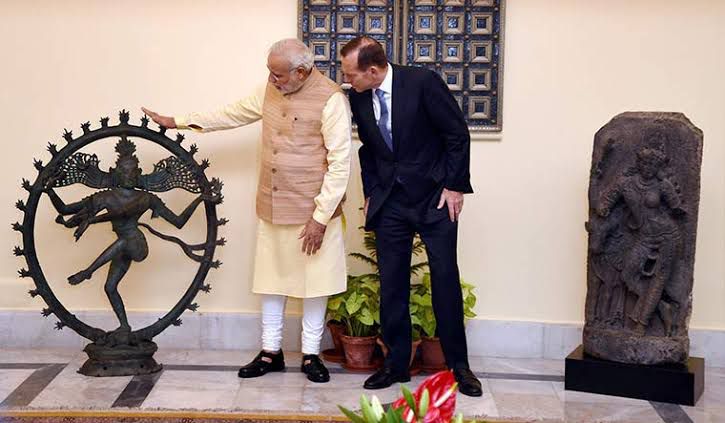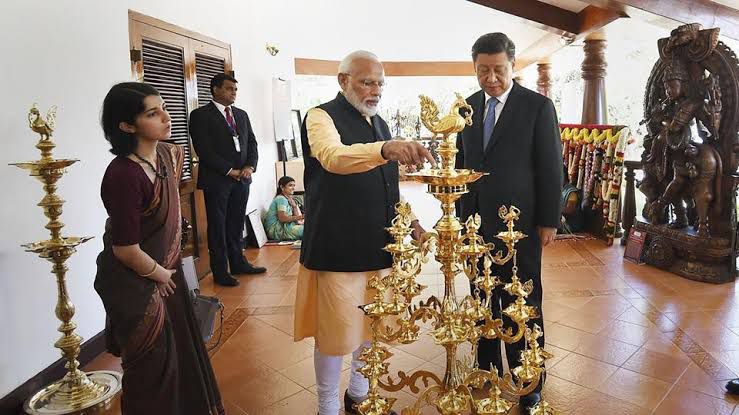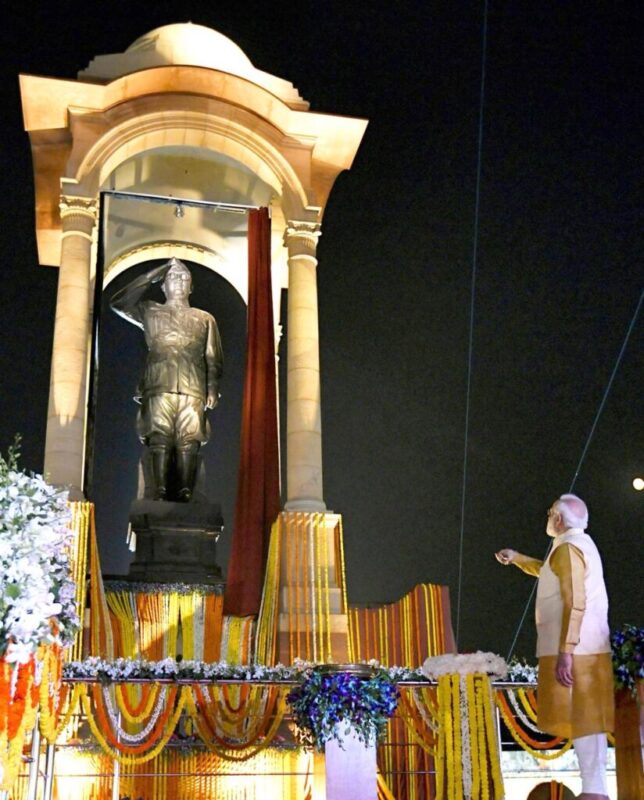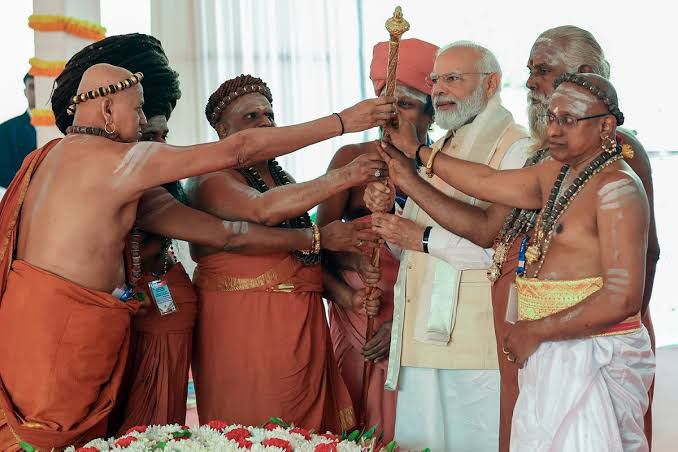When PM Narendra Modi completes his 11 transformative years in office, his government’s achievements are being widely discussed, debated, and appreciated across different sectors. Each department is coming out with their success stories that include far-sighted policies, structured procedures, effective implementation, and targeted results. On the sidelines of these achievements, a silent revolution that the Modi government initiated is the renaissance of our glorious history by replacing the symbols of slavery with a strong and rich cultural identity.
Many renowned thinkers and intellectuals, over different periods, have mentioned the fact that our nation did get freedom, but not complete independence, due to our thought process being clouded with colonial ideas that reflected in practices in our governance, society, economics, and education. There was a growing sense of uneasiness in the society, that while we acknowledge the issue, we were equally struggling to come out with the development of a natural model to erase colonial traces, given the fact that the nation is gifted with such a vast, unique and age old cultural heritage. Through various and sustained efforts, the Modi government intends to preserve ancient civilizational ethos, protect the cultural and spiritual heritage, and to propagate Indian knowledge systems and traditions across the world.

The first sign of assertion came in 1999 during Atal Bihari Vajpayee government’s budget presentation. Earlier, union budgets were presented at 5.00 p.m. of the last day of February, every year, designed to suit Britain’s daytime. The practice was discontinued and 1999 Budget which was presented at 11 a.m. Later Narendra Modi government in 2017, made it on the last day of January every year, so that the fund allocation becomes smooth for every ministry and department well before the fiscal year, which is being practiced till today. Similarly, the practice of carrying the budget papers in a leather suitcase was done away with in 2019, replaced by a Bahi-Khata (Accounts Ledger) wrapped in pouch, which later became digital in 2021. This is not just a symbolic action, but a subtle message to the world from Bharat, that it is ready to reestablish itself.
Our Lok Sabha had two seats reserved for the Anglo-Indian community since 1952. Similarly, the State Legislatures across 14 states – Andhra Pradesh, Bihar, Chhattisgarh, Gujarat, Jharkhand, Karnataka, Kerala, Madhya Pradesh, Maharashtra, Tamil Nadu, Telangana, Uttar Pradesh, Uttarakhand, and West Bengal had one representation each. Art.331 of our Constitution provided the reservation, also mentioned that this would cease to exist 10 years after the commencement of the Constitution. But through repetitive amendments, this reservation was extended to 1970, then to 1980, 1990, 2006, 2010 & 2020. Modi government, in January 2020, through the 104th Constitutional Amendment Act 2019, abolished the Anglo-Indian reserved seats in the Parliament and State Legislatures. Through this amendment, the Modi government expressed its commitment towards the cultural values in our Constitution.

Since 1972, every year on 26 January, Republic Day, it had been customary for the Prime Minister, and the three service chiefs to place wreath at Amar Jawan Jyoti at the India Gate. The demand for a National War memorial was exceedingly long, with the Indian Armed Forces proposed it in 1960. After PM Modi assumed office, the proposal was cleared by his cabinet in 2016, and the completed National War Memorial along with a museum was inaugurated in February 2019. While the India Gate stands a historical monument commemorating soldier of the British Indian Army who died in World War I and the Third Anglo-Afghan War, the National War Memorial is dedicated to all Indian soldiers who have died defending India since its independence. From 2020 Republic Day, PM Modi, flanked by the three chiefs of the armed forces, revisited the custom by laying wreath in the National War Memorial instead of India gate. Thus, PM Modi not only fulfilled a historic demand but also ensured that the sacrifice of our jawans were duly recognized and respected.
Indian Navy was not far behind in participating in the cultural rejuvenation. Its new identity adorned its might with cultural symbolism by shedding its colonial past. The earlier ensign of Indian Navy had the horizontal and vertical red stripes symbolizing the Cross of St. George, which was reminiscent of the colonial era. On 2nd September 2022, PM Modi unveiled the new ensign with the octagonal shape with twin golden borders is inspired from the royal seal of Chhatrapati Shivaji Maharaj along with the navy’s motto in the Devanagari script – शं नो वरुणः (Śhaṁ No Varunaḥ), which means “May the Lord of Water be auspicious unto us” .

To mark the 125th anniversary of Netaji Subhas Chandra Bose, his monolithic statue was installed in the Indian Gate canopy, New Delhi on 8th September 2022. Earlier in 1936, a statue of King George V (1865 -1936) was installed as a tribute to him and was housed in the canopy designed by Edwin Lutyens. After Independence, due to widespread opposition, the statue was removed in 1968. Successive governments contemplated the installation of statues of Mahatma Gandhi and other former prime ministers from Jawaharlal Nehru to Indira Gandhi in the vacant spot. The pedestal remained empty over a period and was subsequently called as ‘Empty Canopy.’ Finally PM Narendra Modi unveiled the 28-ft-tall statue of Bose, and also inaugurated the newly-christened ‘Kartavya Path’, the stretch of road from Rashtrapati Bhavan to India Gate, earlier known as Rajpath. In the statue of Netaji, PM Modi visualized to project his magnificent personality to represent the spirit of India’s valor and courage.
Our new Parliament House is the perfect display of the Modi government’s commitment to our culture. The age-old Parliament House, constructed in 1927, was shifted for more space and operational convenience in 2023. The new building was designed with our cultural flavor with Sanatana Parampara and Vaastu shastra as the guiding principles blended with modern technologies. The Parliament House has three gates named Gyan Dwar, Shakti Dwar, and Karma Dwar. And the building has six entrances named after the auspicious creatures mentioned in our scriptures – Gaja, Ashva, Garuda, Makara, Shardula, and Hamsa, whose statues stand guard on both sides of the respective entrances. 5,000 pieces of art – paintings, wall panels, stone sculptures and metal objects are showcased. The new building is inspired by the sculptures of the Chariot wheel of Sun Temple of Konark and Chanakya. A signature wall called the ‘Jan Janani Janmabhoomi’ which adorns the Central Foyer of the Parliament was created by 75 women artisans from every state of the country, using the soil of each state.
The ‘Sengol’ (Sceptre), installed in the Lok Sabha is the center of attraction in the New Parliament building. Made of silver and plated with gold, the Sengol symbolizes the Indic civilization. It was originally handed over to Jawaharlal Nehru on the eve of Independence Day, 1947 by the Thiruvavaduthurai Aadheenam (one of the ancient and famous Shaiva Mutt of Tamil Nadu) to mark the transfer of power from the British and as a symbolic representation marking our independence. Many famous newspapers and journals, at that time, carried this famous incident in their articles. ‘Sengol’ in Tamil literature represented as a symbol of righteousness and fair governance. However, the same was tagged as ‘Golden walking stick’ and housed in the Allahabad Museum disgracefully. After 75 years, PM Modi restored the glory of the Sengol, by bringing it back and installing it next to the seat of the Speaker of the Lok Sabha, to denote its importance. The historic moment was performed on the inauguration of the New Parliament House on May 2023, in the august presence of the Spiritual Heads of Tamil Shaiva Mutts.
PM Modi always displayed interest in bringing our historic relics back to our country. Shortly after Modi became Prime Minister in May 2014, Australia gave back a stolen 11th century bronze idol of Nataraja from the Chola dynasty and an Ardhanarishwara statue dating back to the 10th century. A stolen Kushan sculpture of a seated Buddha from Mathura, Uttar Pradesh was repatriated to India in 2016 and is currently displayed in the National Museum, Delhi. A stolen marble idol of Lord Brahma and his consort Brahmani from the 12th century was retrieved from London, United Kingdom, in Jan 2018. And an ancient idol of Lord Hanuman, dating to the late Chola period and stolen from a temple in Tamil Nadu brought back in 2023. More than 652 antique artefacts were repatriated to India from different countries, of which 640 antiquities of Indian origin had been brought back to India since 2014 (which include 297 items returned when PM Modi visited in the U.S. in September 2024), and others are in the process of being repatriated from various countries, including the U.S., the U.K., Singapore, and Australia, as per officials in August 2023. The U.S alone has returned 578 items. According to UNESCO estimates, about 50,000 pieces of art stolen from Indian temples are currently in Western museums or private collections. Often, these include statues and paintings of Hindu, Jain, and Buddhist deities.
As a part of cultural diplomacy, PM used to present gifts to world leaders during his visits or whenever he hosts leaders of world countries, which reflected our nation’s rich culture, diversity, and civilization. When Chinese President Xi Jinping visited India in October 2019, he was gifted a 6-feet bronze lamp from Nachiyarkoil, Tamil Nadu and a dancing Saraswati painting of Thanjaur. On January 2022, PM Narendra Modi presented a beautifully crafted tea set from Bulandshahr, Uttar Pradesh, to then UK PM Boris Johnson. Similarly, on October 2024, during the BRICS summit, he presented Uzbekistan’s President Shavkat Mirziyoyev with a traditional Warli painting. In April 2025, during his visit to India, Dubai’s Crown Prince Sheikh Hamdan bin Mohammed bin Rashid Al Maktoum was gifted a striking statue of Maharana Pratap’s legendary horse ‘Chetak’ from Rajasthan. From silk shawls of Varanasi to Dokra artwork from Chhattisgarh, from Madhubani art from Bihar to Patta Chitra art of Odisha, from Channapatna dolls of Karnataka to Kashmiri saffron in gift hampers, the traditional artefacts were gifted, which are manifestation of Indian household products crafted with ingenuity. This also reflects PM Modi’s commitment to his famous slogan ‘Vocal for Local.’
The age old Indian Penal Code (IPC), enacted in 1860, was the earlier official criminal code, inherited from the British after independence. It remained in force until it was repealed and replaced by the Bharatiya Nyaya Sanhita (BNS) in December 2023, which came into effect on July 1, 2024. A complete overhaul of the penal system became necessary to relook at the evolving crimes and to address contemporary issues like cybercrime and terrorism. The BNS aims to decolonize the legal system by removing outdated terms and concepts and attempts to focus on victim protection.
PM Modi initiated the proposal to celebrate Yoga Day, during his address in the United Nations in 2014. The proposal received broader global support, with 177 nations co-sponsoring it. Following which 21st June every year is celebrated as International Yoga Day. Yoga, having pre-Vedic origin is a combination of physical, mental, and spiritual practice, and it is a great gift to the world from our nation. The significance and benefits of Yoga practice to uplift the wellbeing of society was globally acknowledged particularly during and post COVID scenario. Similarly, 2024 November 15, was declared Janjatiya Gaurav Divas celebrated to honor the contributions of tribal communities who have played a crucial role in the nation’s history and development. The day also marks the birth anniversary of Bhagwan Birsa Munda, the famous tribal leader and freedom fighter. The tribal communities played a vital role in our freedom struggle, with movements led by the Santhals, Tamars, Kols, Bhils, Khasis, and Mizos, among others.
As a great nation, we derive strength from our ancient and diverse culture. PM Modi understood the significance and began to emphasize our culture in every forum to establish the indispensable presence of Bharat in the world stage. From diplomacy to economics, from education to architecture, Bharat is re asserting itself by rediscovering its cultural roots. And to position itself as a Vishwaguru, the cultural assertion is essential as it gives clear guidance and direction.
Jai Hind!
(The views expressed are the author's own and do not necessarily reflect the position of the organisation)


